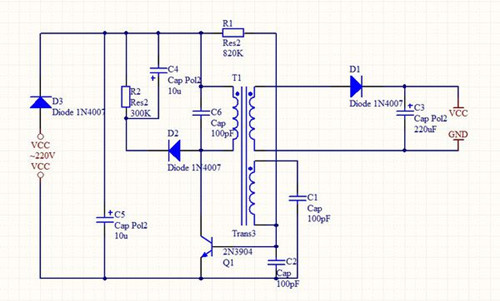
Privacy statement: Your privacy is very important to Us. Our company promises not to disclose your personal information to any external company with out your explicit permission.
![]() October 24, 2021
October 24, 2021
switching power supply is the use of electronic switching devices (such as transistors, field effect transistors, thyristor, etc.) through the control circuit, so that electronic switching devices are constantly "on" and "off", so that electronic switching devices The input voltage is pulse modulated to achieve DC/AC, DC/DC voltage conversion, as well as adjustable output voltage and automatic regulation. Next Xiaobian introduced the principle of switching power Transformer and switching power supplies.

Switching Power Supply principle
The operating principle of switching power supply is different from that of linear power supply. Linear power supply allows power transistor to operate in linear mode, and switching power supply allows power transistor to work in both on and off states, in other words, through “chopping”. That is, the amplitude of the input DC voltage is reduced to a pulse voltage equal to the input voltage amplitude. This working principle of the switching power supply makes the volt-ampere product added to the power transistor very small (in the on state, the voltage is low, the current is large; in the off state, the voltage is high, the current is small), ie, the loss generated in the power transistor Very small.
Switching power supply composition
1, the main circuit
Inrush Current Limit: Limits the inrush current on the input side at the instant of power on.
Input filter: Its function is to filter the clutter that exists in the power grid and hinder the feedback of clutter generated by the unit back to the power grid.
Rectification and filtering: Direct rectification of grid AC power to smoother DC power.
Inverter: The rectified DC power is changed into high-frequency AC power, which is the core of high-frequency switching power supply.
Output rectification and filtering: According to load requirements, provide a stable and reliable dc power supply.
2, the control circuit
On the one hand sampling from the output, compared with the set value, and then to control the inverter, change its pulse width or pulse rate, so that the output is stable, on the other hand, according to the data provided by the test circuit, the protection circuit identification, provide The control circuit performs various protection measures for the power supply.
3, detection circuit
Provides various parameters and various meter data during operation in the protection circuit.
4, auxiliary power supply
The software (remote) that realizes the power supply starts to supply power for protection circuits and control circuits (chips such as PWM).

Reasons for low output voltage of switching power supply
1. 220V AC voltage input circuit and rectifying and filtering circuit are insufficient for the working voltage provided by the switch tube, which exceeds the control range of the pulse width modulation circuit.
2. Excessive current in the load circuit causes the load of the switching power supply to increase, causing the output voltage to drop.
3. The on/off interface circuit is in the standby state, so that the switching power supply operates in the low-frequency oscillation state and its output voltage is the degree in the standby state. This type of fault should only be applied to a model with no pre-power supply and the operating voltage in the CPU's standby state provided by the switching power supply.
4. The end of the open/close interface circuit works in the state between the power on or standby for any reason, resulting in the switching power supply operating at a working frequency between the standby and on state, resulting in the output voltage of the switching power supply being higher than the standby value and being lower than the start value. .
5, the protection circuit end works because of the breakdown in the conduction state, causes the power source to enter the weak vibration narrow pulse power supply, causes the switching power supply output voltage to drop.
6. The diodes and filter capacitors in the rectifier output circuit cause the output voltage to become low due to the damage of the current limiting resistor.
7. There is a problem in the pulse width modulation circuit, which cannot respond to the change of the output voltage of the switching power supply tangently, and the direction of the base voltage adjustment of the power switch tube is wrong, resulting in a low output voltage of the switching power supply.
8. The positive feedback resistance in the positive feedback circuit increases, the performance of the discharge diode deteriorates, and the amount of positive feedback is insufficient, resulting in a long oscillation period. The oscillation frequency drops, causing the switching power adaptor output voltage to be low.
9. Its oscillating switching Power Supplies operates at a lower frequency than the low frequency state because it is not reversed, resulting in a low output voltage.
Editor's summary: The principle of switching power supply and the composition of switching power supply are introduced here, and we hope to help everyone. If you want to know more related information, you can pay attention to this website information.
The above is the Switching power supply principle switching power supply composition we have listed for you. You can submit the following form to obtain more industry information we provide for you.
You can visit our website or contact us, and we will provide the latest consultation and solutions
Send Inquiry
Most Popular
lastest New
Send Inquiry

Privacy statement: Your privacy is very important to Us. Our company promises not to disclose your personal information to any external company with out your explicit permission.

Fill in more information so that we can get in touch with you faster
Privacy statement: Your privacy is very important to Us. Our company promises not to disclose your personal information to any external company with out your explicit permission.